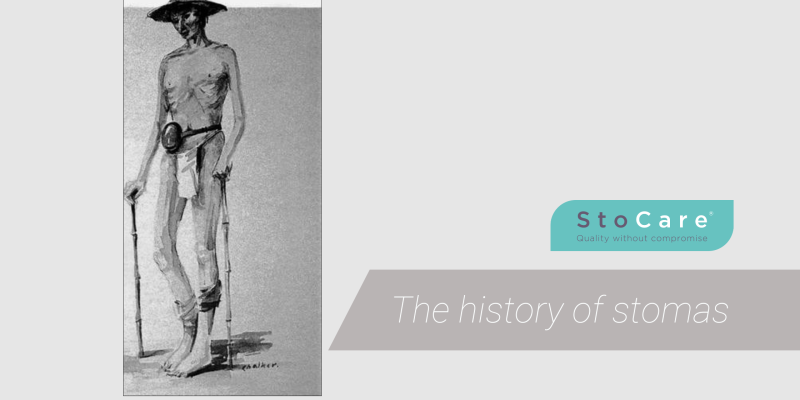With over 200,000 people in the UK living with a stoma, and people in the public eye breaking the stigma, it’s hard to imagine a world where they weren’t a treatment option. But it wasn’t always this way. For centuries, people living with bowel or bladder issues had to navigate painful conditions with very limited medical support. We’ve taken a look back at the fascinating (and sometimes harrowing) evolution of stoma care. Read on to discover the history of stomas.
Ancient history of stomas
400BC – References to managing intestinal injuries date back to Hippocrates and Celsus, with surgical methods described as early as 400BC, though outcomes were typically fatal.
17th century – Physicians documented attaching the intestine to the abdominal wall using tubes or sutures, but these surgeries were dangerous and experimental. Serious bowel conditions like intestinal blockages were often fatal. Mercury was commonly used to stimulate the bowel and patients often died from mercury poisoning.
When was the first stoma operation?

1776 – The first successful recorded colostomy was performed. Attempts had been made before this with fatal results.
1879 – The first successful recorded ileostomy was created by German surgeon Dr. Baum. It was flush to the skin, causing inevitable peristomal skin complications.
1909 – American surgeon Dr. Eugene Shoemaker performed the first recorded urostomy.
These marked pivotal moments in surgical innovation, though the procedure was reserved for the most extreme cases.
This was partly because appliance options were nonexistent. If a person survived surgery, they would use makeshift solutions such as sponges, rags, metal cups, glass jars or fabric pouches to try to manage their output. It was uncomfortable, ineffective and carried serious risks of infection.
The invention of this surgery was not well received in the medical community for fear of ruining their career, because death was often the end result. It was a last resort for severe cases of things like obstructions and inflammatory bowel disease.
The history of stomas – 1900s
By the 20th century, however, stoma surgery and care rapidly improved.
- 1912 – John Y. Brown, an American surgeon, pioneered a major advancement in stoma surgery with the creation of a spouted ostomy (as opposed to flush to the skin). It was held in place by a surgical clamp and emptied through a catheter which was sutured in place. This was an improvement but still resulted in peristomal skin complications and bowel blockages.
- 1940s – Dr. Bryan Brooke from Birmingham, England, performed a groundbreaking ileostomy surgery that created a spout without the need for a clamp or a catheter, which to this day remains the “gold standard” in ileostomy surgery.
- 1950s – The first reusable rubber stoma appliances began to appear. These devices were strapped or taped to the abdomen.

- 1950 – The first ileo-conduit surgery was performed, revolutionising urostomy surgery.
- 1954 – Danish nurse Elise Sørensen invented the first disposable, self-adhesive stoma bag. Her motivation was her sister, who had a stoma but was too embarrassed to leave the house. Elise’s invention laid the foundation for the modern stoma bags we use today.
- 1956
- The Ileostomy and Internal Pouch Association (UK) was founded.
- President of the United States Dwight D. Eisenhower underwent colostomy surgery to bypass a bowel obstruction.
- 1960s – Companies in the USA began to develop vinyl semi-disposable pouches which lasted up to 12 weeks and were far more comfortable than rubber pouches.
- 1962 – The United Ostomy Association was founded.
- 1967 – Colostomy UK was founded.
- 1970s – Stoma products were becoming more user-friendly and discreet. Key developments included:
- Semi-disposable two-piece systems
- Thinner adhesives and improved skin barriers (including the first use of hydrocolloid)
- More comfortable and lower-profile pouches
- 1976 – British surgeon Dr. Alan Parks pioneered ileo-anal pouch surgery (also known as J-pouch). This surgery allowed some patients to avoid a permanent stoma entirely by connecting the small intestine directly to the anus.
- 1976 – The Urostomy Association (UK) was founded.
- 1982 – An article was published in the New York Times entitled ‘Ostomies: No longer the secret surgery‘. It’s about Rolf Benirschke, a famous NFL player who amazingly played with a stoma.

- 1982 – The Jacob’s Well charity was founded, who (amongst other things) distribute stoma appliances to countries where they are scarcely available.
- 1986 – Frank Sinatra cancelled a performance due to severe abdominal pain and underwent colostomy surgery to treat diverticulitis.
- 1990s – Further refinement in materials and fit, making stoma appliances more skin-friendly, leak-resistant and tailored to individual needs.
- 2000s – Companies continue to develop stoma products, including:
- Improved filters
- Integrated closures
- Fabric-covered pouches
- Convex baseplates
- Accessories such as seals, odour eliminators, skin barriers, and adhesive removers.
- 2007 – StoCare was founded, aiming to enable stoma patients to maintain healthier peristomal skin while providing the best possible prices for the NHS.
- 2015 – A Bear Named Buttony was founded, a Scottish charity which supports children with stomas.
- 2016 – Innovative FLOWASSIST technology is unveiled by Ostoform, aiming to reduce leakage for all ostomates.

- 2024
- Mollie Pearce discussed her ileostomy while appearing on The Traitors, the hit ITV show that attracted over 8 million UK viewers.
- Lego released a minifigure with a stoma, called Sara.
- Coronation Street featured a storyline where Bethany Platt needed stoma surgery after botched cosmetic surgery.
- Hollyoaks featured a storyline where Mercedes McQueen had stoma surgery to treat bowel cancer.
- Marks and Spencer became the first high street retailer to sell a range of stoma knickers.
Today
Stoma care now champions innovation, comfort and community. New products are being released all the time, with innovative technology designed to improve the lives of ostomates. Meanwhile, stomas are becoming more and more visible in the public eye.
The future
The future of stoma care is bright and full of promise. With ongoing developments in technology, personalised medicine and surgical techniques, we’re likely to see even more discreet, adaptive, and eco-friendly options on the horizon.
There’s also growing attention toward mental health support and education so that stomas become more normalised and understood in society.
How has your own experience with stoma care changed? What innovation has meant the most to you?

Sources
https://www.sciencedirect.com/science/article/abs/pii/S0065341112000164
https://pmc.ncbi.nlm.nih.gov/articles/PMC4370532
Further reading
Why would you need a stoma bag?



